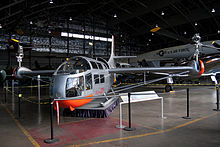Bell XV-3
The wingtip rotor assemblies were mounted to tilt 90 degrees from vertical to horizontal, designed to allow the XV-3 to take off and land like a helicopter but fly at faster airspeeds, similar to a conventional fixed-wing aircraft.
Although it was limited in performance compared to later types, the aircraft successfully demonstrated the tiltrotor concept, accomplishing 110 transitions from helicopter to airplane mode between December 1958 and July 1962.
By April, the aircraft had expanded the flight envelope to 127 miles per hour (204 km/h) as well as demonstrating full autorotation landings and 30-degrees forward transitions with the rotor pylons.
[4] Flight testing at the Bell facilities was completed on 24 April 1959, and the aircraft was shipped to Edwards Air Force Base.
Promoted to the rank of Major, Robert Ferry would coauthor the report on the military flight evaluations, conducted from May to July 1959, noting that despite the deficiencies of the design, the "fixed-wing tilt-prop," or tiltrotor, was a practical application for rotorcraft.
[citation needed][6] Testing would continue through July 1962 as NASA and Bell completed wind tunnel testing to study pitch-flap coupling exhibited by the tiltrotor in an effort to predict and eliminate the aeroelastic dynamic rotor instability (referred to simply as pylon whirl) that had caused problems throughout the program.
In April 1966, Bell Helicopter aerodynamicist Dr. Earl Hall published an analysis of the XV-3 program data explaining the tiltrotor aircraft pylon whirl instability.
[6] In late 1966, the sole remaining XV-3, serial number 54-148, was moved to outside storage at Davis–Monthan Air Force Base in Tucson, Arizona.
[8] In 1984, the Bell XV-15 flight test team discovered the aircraft stored outside the Army's Aviation Museum during the XV-15 visit to Fort Rucker, Alabama, as part of a demonstration tour.
[9] 54-148 was repaired by December 1986, with Army support and the leadership of former Bell XV-3 engineer Claude Leibensberger, but the aircraft was disassembled and placed into indoor storage.
[8][11] In 2005, Bell Helicopter employees began work to restore 54-148 to museum display condition, this time led by former XV-3 engineer Charles Davis.






